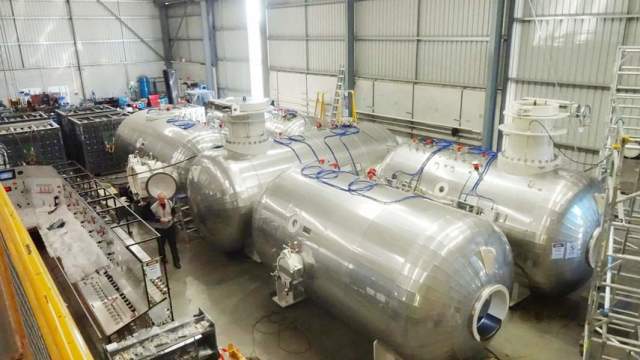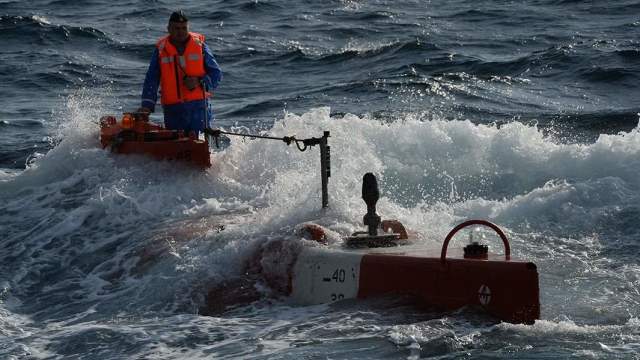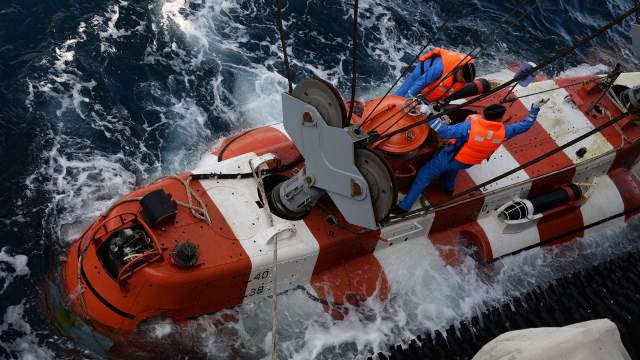Special complexes can be placed on almost any vessels up to tugs and ferriesThe arsenal of means of rescue of the Russian Navy has been replenished with a new complex that is able to assist ships in distress, ships and even submarines.
All its equipment is mounted in ordinary shipping containers. If necessary, they can be placed on the deck of any suitable watercraft or even on an unprepared shore. The complex includes special systems for pumping water, fire and rescue equipment, as well as everything necessary for deep—sea operations. According to experts, this makes it possible not to depend on the availability of specialized rescue ships in the disaster zone and to promptly provide the sailors with all the necessary assistance.
Three containers
Deliveries of the latest rescue systems to the units of the Russian Navy began last fall, sources in the military department told Izvestia. The first sets have already been delivered to the Northern and Pacific Fleets. The novelty includes several sea containers with rescue equipment installed in them.
The first container is equipped with systems that allow pumping water from ships in distress, ships and even submarines. The second one is equipped with fire extinguishing systems and the necessary tools for rescue operations. The third container contains equipment for deep-sea operations on board submarines.
According to the interlocutors of the publication, several exercises have already been conducted in the fleets to master the new rescue system. In particular, the containers were placed on board ordinary ships, as well as warships. They were transported by road, rail and even air transport.

GVK-450 deep-sea diving complex
Image Source: Photo: Tetis-pro.ru
— Russia and the Soviet Union, unfortunately, are taught by loud accidents of submarines, — military historian Dmitry Boltenkov told Izvestia. — We still remember Kursk. Therefore, the tasks of search and rescue support for submarines and surface ships are very important for us. The advantage of containers is that they can be loaded onto any vessel where there is a platform of the appropriate size, for example, on one of the tugs that are currently being built, or on ferries—type vessels where there is a crane. It is not necessary to have a specialized ship (after all, it may be under repair or in another area at the right time). Much more effective are modular containers and a team of rescuers with whom you can go to sea on the ship that is at hand. This is a modern promising way of development, which is the future.
Find and Save
Such systems are relevant for the fleet, Admiral Valentin Selivanov, ex-chief of the General Staff of the Navy, told Izvestia.
— Although, when I served myself, we did not think on ships how we would be saved in case of something. I only thought about how to sink submarines, fight aircraft carriers. But the country, the navy, and the designers must take care that the crew members can count on rescue in case of damage to the ship. It is especially important that the new system, containers can be installed on almost any vessel," he stressed.

Rescue underwater deep-sea vehicle "Bester-1"
Image source: Photo: RIA Novosti/Vitaly Ankov
Special pop-up rescue cameras are now provided on the same submarines, Valentin Selivanov recalled. However, in an emergency, the crew does not always have the opportunity to use them.
— Therefore, all the innovations that are being invented now are of great importance for the crews, — he summed up.
In recent years, the Navy has changed the system of providing assistance to submarines in distress. Now all possible means are involved in the rescue operations of submarine crews, and not only the vessels of emergency services. Anti-submarine ships, minesweepers and anti-sabotage boats are involved in the search for submarines in trouble.
After the Kursk submarine accident, Russian shipbuilders were tasked with developing special vessels to rescue the crews of emergency submarines lying on the ground or in a surface position. This is how the 21300C "Dolphin" series was designed. The lead ship, the Igor Belousov ocean—class rescue vessel, was laid down in 2005 and launched in 2012. He is currently serving in the Pacific Fleet. Earlier it was reported that the construction of four "Dolphins" is planned in the state armament program for 2018-2027, but there is no information about the progress of work in open sources.
Flag raising ceremony on the rescue vessel "Igor Belousov"
Image source: Photo: RIA Novosti/Igor Russak
"Igor Belousov" has no analogues in the world in terms of its capabilities. He can not only evacuate the crew of an emergency submarine, but also organize the supply of air, electricity and rescue equipment to its board. With the help of inhabited and uninhabited underwater vehicles, "Dolphin" is able to search and survey emergency facilities.
The basis of the vessel's rescue equipment is the GVK—450 deep-sea diving complex. It can dive to a depth of 450 m and lift sailors from an emergency submarine to the surface, providing decompression in pressure chambers to 60 submariners at the same time. The complex includes five pressure chambers, a diving bell and a rescue underwater deep-water vehicle "Bester-1", capable of operating at depths up to 720 m.
In addition to the Igor Belousov, the Soviet-built rescue ship Alagez serves in the Pacific Fleet. On the Black Sea — "Epron", which celebrated its 60th anniversary last year.
Roman Kretsul

